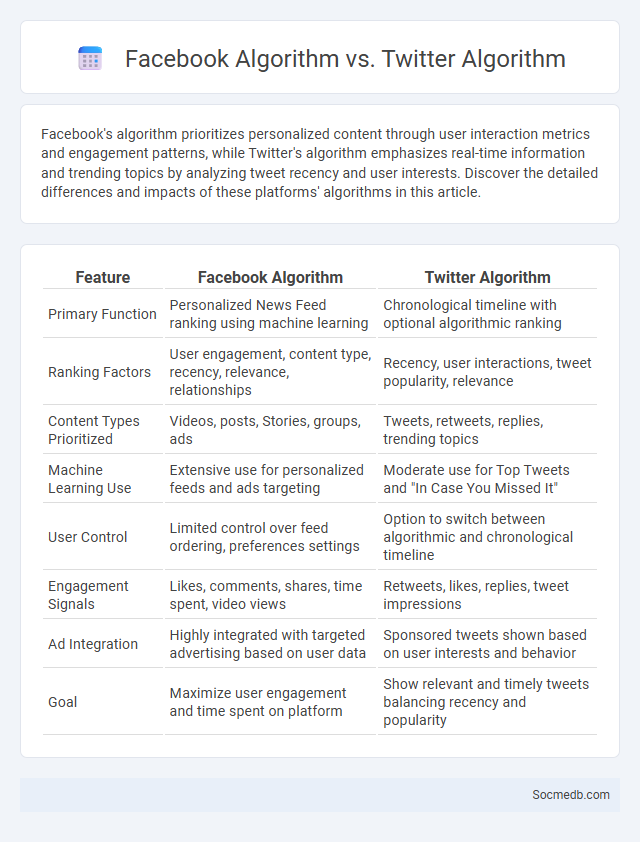
Photo illustration: Facebook Algorithm vs Twitter Algorithm
Facebook's algorithm prioritizes personalized content through user interaction metrics and engagement patterns, while Twitter's algorithm emphasizes real-time information and trending topics by analyzing tweet recency and user interests. Discover the detailed differences and impacts of these platforms' algorithms in this article.
Table of Comparison
| Feature | Facebook Algorithm | Twitter Algorithm |
|---|---|---|
| Primary Function | Personalized News Feed ranking using machine learning | Chronological timeline with optional algorithmic ranking |
| Ranking Factors | User engagement, content type, recency, relevance, relationships | Recency, user interactions, tweet popularity, relevance |
| Content Types Prioritized | Videos, posts, Stories, groups, ads | Tweets, retweets, replies, trending topics |
| Machine Learning Use | Extensive use for personalized feeds and ads targeting | Moderate use for Top Tweets and "In Case You Missed It" |
| User Control | Limited control over feed ordering, preferences settings | Option to switch between algorithmic and chronological timeline |
| Engagement Signals | Likes, comments, shares, time spent, video views | Retweets, likes, replies, tweet impressions |
| Ad Integration | Highly integrated with targeted advertising based on user data | Sponsored tweets shown based on user interests and behavior |
| Goal | Maximize user engagement and time spent on platform | Show relevant and timely tweets balancing recency and popularity |
Introduction to Social Media Algorithms
Social media algorithms are complex mathematical formulas designed to personalize content based on user behavior, preferences, and engagement patterns. These algorithms analyze data such as likes, shares, comments, and viewing time to prioritize and display content most relevant to individual users. Platforms like Facebook, Instagram, and TikTok continuously update their algorithms to enhance user experience and increase content visibility through machine learning and artificial intelligence techniques.
What is an Algorithm?
An algorithm is a set of rules or instructions used by social media platforms to analyze user behavior and preferences, determining which content appears in their feeds. These algorithms prioritize posts based on factors such as engagement rates, relevance, recency, and user interactions to deliver personalized experiences. Understanding how algorithms work is crucial for optimizing content visibility and maximizing audience reach on platforms like Facebook, Instagram, and TikTok.
How Facebook’s Algorithm Works
Facebook's algorithm prioritizes content based on user engagement signals such as likes, comments, and shares to deliver a personalized news feed tailored to Your interests. It employs machine learning techniques to analyze your interactions and predict which posts will keep You most engaged, favoring meaningful social interactions over passive content. The algorithm constantly updates to balance relevance, recency, and content type, ensuring the most pertinent information appears on Your feed.
How Twitter’s Algorithm Works
Twitter's algorithm prioritizes content based on your engagement history, relevance, and recency to deliver a personalized timeline. It uses machine learning to analyze factors like tweet interactions, the popularity of content, and the relationships between users to rank tweets. Understanding this system can help you optimize your posts for better visibility and reach on the platform.
Comparing Facebook and Twitter Algorithms
Facebook's algorithm prioritizes content based on user interactions, such as likes, comments, and shares, while Twitter's algorithm emphasizes recency and relevance through retweets, likes, and user engagement metrics. Both platforms use machine learning to personalize user feeds, with Facebook focusing more on maintaining longer session durations and Twitter optimizing real-time information flow. Understanding these key differences helps marketers tailor content strategies to maximize reach and engagement on each social network.
Ranking Signals: Facebook vs Twitter
Facebook's ranking signals prioritize user engagement metrics such as likes, shares, comments, and video watch time, which highlight content relevance and authenticity. Twitter emphasizes recency, retweets, likes, and mentions to boost content visibility, with hashtags playing a crucial role in discoverability and trending topics. Both platforms use algorithmic assessments of user interaction patterns, but Facebook's focus leans more toward personal connections and community engagement, while Twitter centers on real-time information and viral content spread.
Content Visibility and Engagement Features
Social media platforms enhance content visibility through algorithms that prioritize relevant and trending posts, increasing the likelihood that your content reaches a larger audience. Engagement features such as likes, comments, shares, and interactive stories boost user interaction and foster community building. Utilizing these tools effectively can significantly improve your brand's online presence and audience engagement metrics.
Personalization and User Experience
Social media platforms leverage advanced algorithms and machine learning to deliver highly personalized content that aligns with individual user preferences, increasing engagement and satisfaction. Enhanced user experience is achieved through intuitive interfaces, real-time notifications, and adaptive features that respond to user behavior. Personalization and seamless interaction collectively drive higher retention rates and foster deeper community connections.
Algorithm Updates and Impact on Users
Algorithm updates on social media platforms significantly influence the visibility and engagement of your content by altering feed rankings and recommended posts. These changes often prioritize personalized experiences, favoring content that aligns with user interests and behavior patterns, which can affect reach and interaction metrics. Understanding these updates helps you adapt strategies to maintain audience connection and optimize content performance.
Future Trends in Social Media Algorithms
Future trends in social media algorithms emphasize enhanced personalization through advanced machine learning techniques that analyze user behavior in real-time, improving content relevance and engagement. Integration of AI-driven sentiment analysis and natural language processing enables platforms to filter misinformation and promote authentic interactions. Emerging algorithms prioritize privacy-preserving data processing, balancing personalized experiences with increased regulatory compliance and user trust.
 socmedb.com
socmedb.com